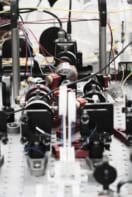
Light-induced electron emissions from fullerene, a carbon-based molecule, can be used to make an ultrafast switch. The new device, developed by a team headed up at the University of Tokyo, Japan, has a switching speed that’s four to five orders of magnitude faster than that of current solid-state transistors used in modern-day computers. The path of the electrons produced from the emission sites in the molecule can be controlled on the sub-nanometre scale using pulses of laser light.
“Prior to this work, such optical control of electron emission sites was possible on a scale of 10 nm, but it was difficult to miniaturize these electron sources with emission site selectivity,” explains Hirofumi Yanagisawa of the University of Tokyo’s Institute for Solid State Physics.
The researchers made their single-molecule switch by depositing fullerene molecules on the tip of a sharp metallic needle and applying a strong constant electric field at the tip’s apex. They observed single-molecule protrusions appearing on the apex and found that the electric fields become even stronger on these bumps, allowing electrons to be emitted selectively from these single molecules. The emitted electrons come from the metal tip and only pass through the molecules on the protrusions.
Switching function is like a railroad track
“The electron emission sites of a single-molecule electron source are determined by the way electrons are distributed in the molecule, or molecular orbitals (MOs),” explains Yanagisawa. “The distribution of the MOs largely changes with molecular levels and if the electrons supplied from the metal tip are excited by light, those electrons pass through different MOs as compared to those that aren’t excited. The result is that the emission sites can be changed using light.”
This switching function, he says, is conceptually the same as that of a train being redirected on a railroad track – the emitted electrons can either remain on their default course or be redirected.
The fact that photoexcited electrons can pass through different MOs compared to unexcited ones implies that we should be able to further change these orbitals and so integrate multiple ultrafast switches into a single molecule, Yanagisawa adds. Such structures could then be used to create an ultrafast computer.

Quantum physics sets a speed limit for fastest possible optoelectronic switch
Another possible application is to improve the spatial resolution of photoelectron emission microscopy. Prior to this study, explains Yanagisawa, this technique was sub-10 nm, but it could now achieve 0.3 nm (which is small enough to resolve single-molecule MOs). “We can thus use our ‘laser-induced field emission microscope’ (LFEM) as we have called it to follow ultrafast dynamics in single molecules,” he tells Physics World. “Such molecules could include biomolecules such as those associated with photosynthesis, which are thought to involve femtosecond-time-scale electron processes.”
In their future work, the Tokyo researchers hope to further improve the spatial resolution of their LFEM technique so that they can resolve the atomic structure of a single molecule. They are performing this work as part of the PRESTO project.
The researchers report their work in Physical Review Letters.



